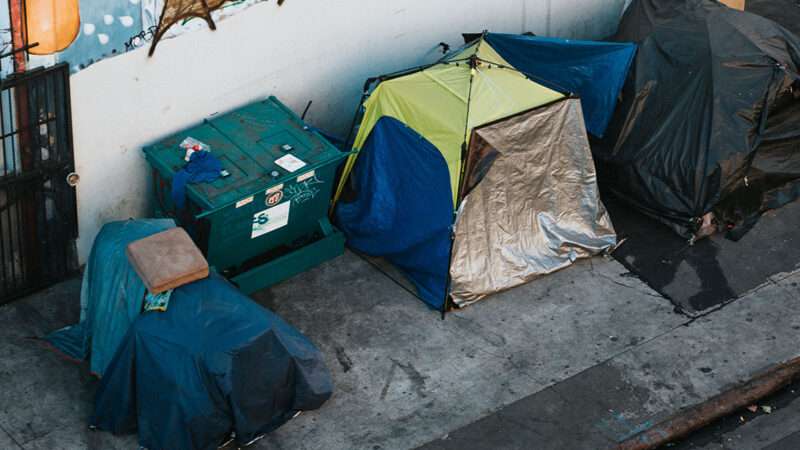
Choosing the Streets Over Shelters Is Dangerous for Everyone
Affirmative: Jared Meyer

Walking through downtowns across the United States, one could be excused for becoming numb to outbursts from visibly disturbed and impaired individuals. Two decades ago, the idea that major American cities would condone (or in some cases, encourage) this situation was unthinkable. If a person was unable to take care of themselves, the options were moving to shelter or, if illness put themselves or others at risk, a clinical setting. Tent-filled homeless camps that stretch across city blocks or throughout public parks were simply not on the table.
A recent UCLA study confirmed the obvious: More than 75 percent of the unsheltered homeless surveyed have a substantial mental health problem, 75 percent have an alcohol or drug addiction, and the majority suffer from both. These afflictions, not a lack of housing, drive street homelessness in America. Choosing to live with the waste, disease, and violence that accompanies homeless camps is a clear sign that someone is not in control and needs an intervention. The only way to solve this problem is to force people off the streets and into safer settings that can treat the root causes of homelessness.
Imagine if you were suffering from untreated schizophrenia or an out-of-control addiction to opioids and found yourself living in a dangerous street camp. You distrust everyone in the system and perhaps do not even realize you are sick. Would you want your loved ones or the government to be able to get you help even if you did not want it? Many people of sound mind would, by force if necessary.
Moving homeless individuals off the streets works. After Los Angeles cleared its notorious Skid Row in 2006, the number of homeless deaths in the city dropped by half. A 2010 study showed that the successful campaign also led to a 40 percent reduction in violent crime, with no spillover effects into other communities.
It is also clear what happens when cities repeal or refuse to enforce their bans on homeless camping in public places. When Los Angeles began allowing the proliferation of street camps again in 2014, the city saw homeless deaths quadruple to five a day. This is a much higher death rate than U.S. soldiers in Iraq and Afghanistan saw during the heights of the wars there. The Phoenix government does not enforce its camping ban, and more than 500 homeless people died on the city's streets in the first half of 2022. Most of these deaths were caused by drug use, but almost one in 10 were homicides.
After Austin repealed its ban in 2019, the city saw a 45 percent increase in unsheltered homelessness even as the number of people staying in shelters dropped. Deaths among Austin's homeless numbered 77 just a decade ago, but rose to 256 in 2020 after the camping ban ended (almost none of which were COVID-related). After 2019, Austin also endured double-digit increases in violent crimes involving the homeless. This is unsurprising, as neighborhoods next to street camps have higher levels of armed robbery, rape, and aggravated assault. The victims of these crimes are often other vulnerable homeless individuals.
Some homeless people need more than shelters and services to stabilize and get better. Unfortunately, mental health commitment laws, which states changed in response to past abuses and pressure from civil liberty groups, make it too difficult for those experiencing a major mental crisis to get help. According to the Treatment Advocacy Center, a national advocate for psychiatric treatment, four states require family or friends to refuse to help their loved ones for them to be eligible for some types of commitment. States often do not have "psychiatric deterioration" nor "grave disability" standards, which limits the services individuals can receive when they are clearly suffering from severe mental illness or addiction. Even when the standards for involuntary care are met, states' maximum inpatient hold and outpatient supervision times are often too short to lead to lasting change.
Those who oppose moving the homeless off the streets on individual liberty grounds often fail to distinguish between public and private property. (The United States finds itself in the odd position of overregulating private property while underregulating public property.) As much as some may hope otherwise, roads and most parks remain public property in cities. Government having and enforcing ordinances that regulate what is acceptable in these public places is necessary to protect public safety, personal property, and general order. The popularity of camping bans in referendums and opinion polls shows local residents know that in dense urban areas, allowing individuals to use public space however they choose is a recipe for disaster.
Solving unsheltered homelessness, along with the causal factors of mental illness and addiction, is difficult. But the current "solution" of choosing the streets over shelters and health care facilities is not working. All levels of government need to update their approaches and move individuals off the streets into safer alternatives—without their consent if necessary.
Don't Lock Up People Who Haven't Committed a Crime
Negative: Mike Riggs
In 1963, nearly 600,000 Americans lived in state-run hospitals because medical authorities insisted they were mentally ill and couldn't live alone or with loved ones. In an address he gave that year to Congress, President John F. Kennedy described the facilities where these men and women were held, many against their will, as "unpleasant institutions from which death too often provided the only firm hope of release." The libertarian psychiatrist Thomas Szasz, in a 2000 interview with Reason's Jacob Sullum, called them "feudal slave estates."
When a midcentury progressive Democrat and a firebrand classical liberal conclude that a government policy stinks, it stinks.
Kennedy's alternative to mass institutionalization for both the mentally ill and the intellectually disabled (who accounted for an additional 200,000 victims of institutionalization in 1963) was to shift federal funding from state-run hospitals to community treatment centers that could help patients without pulling them from their neighborhoods, families, and homes. "When carried out, reliance on the cold mercy of custodial isolation will be supplanted by the open warmth of community concern and capability," Kennedy told Congress. "Emphasis on prevention, treatment and rehabilitation will be substituted for a desultory interest in confining patients in an institution to wither away."
Szasz, who spent his career arguing against the idea that mental illnesses are actual illnesses, wanted to simultaneously abolish all forms of involuntary psychiatric care and the insanity defense. He insisted that people who behaved violently should be incarcerated regardless of the psychological impetus for their behavior. People who merely acted weirdly or believed weird things, on the other hand, should be left to their own (nonviolent) devices. Szasz insisted that no one has the authority to stop an adult from hurting themselves. A homeless man who attacks a passerby should be tried and punished for assault and battery; a homeless man who claims to be Jesus and uses fentanyl in the open should not.
The Szaszian approach is too Manichean for criminal justice reformers and too soft for law-and-order types, but it at least has a limiting principle. Mentally ill people can be deprived of their liberty only as a form of punishment and only if they victimize someone; they cannot be deprived of their liberty to merely deliver them from temptation or risk.
The Supreme Court contributed to deinstitutionalization when it ruled in O'Connor v. Donaldson (1975) that the state and its agents cannot confine people indefinitely simply because they have been diagnosed with a mental illness. Kenneth Donaldson, the plaintiff in that case, was involuntarily committed to a state-run psychiatric hospital in Florida in 1957 because his father said he experienced delusions. Donaldson spent the next 15 years in a crowded asylum, refused his freedom by J.B. O'Connor, the hospital superintendent, who testified that Donaldson was never violent, suicidal, or in need of therapy. He was simply a person with schizophrenia and thus belonged in the care of the state.
The old institutional model, which vacuumed up people like Donaldson and dismissed their indignation as a medical symptom, was itself a wide-reaching disease. At their peak, state mental hospitals contained three times as many people as are currently in federal prison—at a time when the U.S. population was roughly 60 percent of what it is now.
Scott Alexander, the pseudonymous blogger and San Francisco–based psychiatrist, supports a fusion of the Szaszian and community care approaches. "In my model," he wrote in 2016, "the overwhelming majority of mentally ill people can live okay lives outside of any institution, hopefully receiving community care if they want it. If they commit crimes they will go to prison just like anyone else."
Community care has never received the federal funding that Kennedy intended, but it does exist, even in places with large populations of mentally ill unhoused persons. But no policy model can eradicate homelessness. Not everyone on the street wants or can benefit from intervention. Involuntary commitment, even for the short, multiday periods currently allowed under most state laws, often exacerbates feelings of paranoia. Holding patients indefinitely turns them into prisoners. The only comprehensive solution—make homelessness illegal, and aggressively enforce that law—would be unconstitutional and barbaric.
But there is low-hanging fruit. Allow developers to build more housing to drive down prices. End the drug war so that opioid users know what they're putting into their bodies. Stand up to NIMBY ("not in my backyard") activists, who routinely insist on ghettoizing services for the poor and sabotaging the efforts of private actors like outdoor soup kitchens. And yes, those who are violent or destructive should have their liberties revoked in proportion.
There is no easy solution, but there is a very obvious bad one: locking away people for the grave sin of not having curtains to hide their faults.
Subscribers have access to Reason's whole May 2023 issue now. These debates and the rest of the issue will be released throughout the month for everyone else. Consider subscribing today!
- Debate: It's Time for a National Divorce
- Debate: Artificial Intelligence Should Be Regulated
- Debate: Democracy Is the Worst Form of Government Except for All the Others
- Debate: To Preserve Individual Liberty, Government Must Affirmatively Intervene in the Culture War
- Debate: The E.U. Was a Mistake
- Debate: The U.S. Should Increase Funding for the Defense of Ukraine
- Debate: Mentally Ill Homeless People Must Be Locked Up for Public Safety
- Debate: Despite the Welfare State, the U.S. Should Open Its Borders
- Debate: Cats Are More Libertarian Than Dogs
- Debate: Make Housing Affordable by Abolishing Growth Boundaries, Not Ending Density Restrictions
- Debate: Bitcoin Is the Future of Free Exchange
- Debate: Be Optimistic About the World
The post Debate: Mentally Ill Homeless People Must Be Locked Up for Public Safety appeared first on Reason.com.







